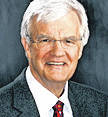
The media is focused on the Democrats’ bright prospects for winning control of the House this November. But the gains they expect to make in governor’s races may be more important to the party’s long-term future.
Of 36 gubernatorial seats up for grabs this year, 26 are held by Republicans. The Democrats’ top targets are Ohio, Florida and Michigan, where they have been out of power for years. If they succeed, the party stands to gain strength on three critically important fronts:
Policy issues ranging from Medicaid expansion to environmental protection and gay rights. Congressional and state legislative redistricting after the 2020 census. National candidate development: Two of the past three Democratic presidents were governors, but the ranks have been thin recently.
“The governor’s races this year are even more important than Congress,” says Terry McAuliffe, who just stepped down as Virginia governor and is a former party chairman. Republicans remember the impact of their 2010 sweep. They devoted huge resources to state races, then dominated redistricting the next year. The result: a policy and political counterweight to a Democratic White House.
The fruits of state battles are already becoming clear. The GOP’s gerrymandering in Pennsylvania in 2011 was overturned this year, thanks in part to help of a Democratic governor who took office in 2015. The result? Three to five House seats this fall, Democrats say.
But they still are suffering from partisan lines in Ohio, Michigan and Florida. All three are purple; only a third of their combined 57 members of the House are Democrats.
In recent months, in part reflecting a national tide, Democrats have become more optimistic about contests in Ohio and Michigan.
Richard Cordray, who clashed with Trump as the head of the Consumer Financial Protection Bureau, is the party’s preferred candidate in Ohio. He should be a strong general election candidate if he avoids getting beat up in the primary by left wing provocateur Dennis Kucinich, the former congressman. That probably would set up a rematch with Attorney General Mike DeWine, who narrowly won in 2010, in a climate friendlier to Republicans.
In Michigan, the political and labor union establishment has gotten behind Gretchen Whitmer, a former state legislative leader, one of many women this year riding the energy of the MeToo movement. She would be a slight favorite in a November race against the state’s Republican attorney general.
In Florida, where the primary isn’t until August, the contests in both parties are unsettled. Still, Democrats say Trump has energized important elements of their voters, younger women and Latinos.
Republicans seem certain to hold Texas and Democrats New York and California. After this week’s primary, Democrats expect to flip Illinois.
Governors aren’t as directly affected by the Trump factor as are members of Congress, but the gathering blue wave represents a major force nevertheless. Two Republican governors in Democratic states, Charlie Baker in Massachusetts and Larry Hogan in Maryland, having distanced themselves from Trump are in good shape.
Both sides are looking for a surprise. Republicans think they may turn Minnesota if former Governor Tim Pawlenty, after more than five years as a Washington lobbyist, returns. Democrats are also bullish on finally unseating Wisconsin’s Gov. Scott Walker, who has been dashing to the political center.
Overall, the opportunities for Democratic pickups range from Nevada and New Mexico in the West to Iowa in the Midwest to Maine on the East Coast. That’s why Terry McAuliffe is upbeat: “The future of the Democratic Party will be decided in state capitals and it’s looking very good.”


